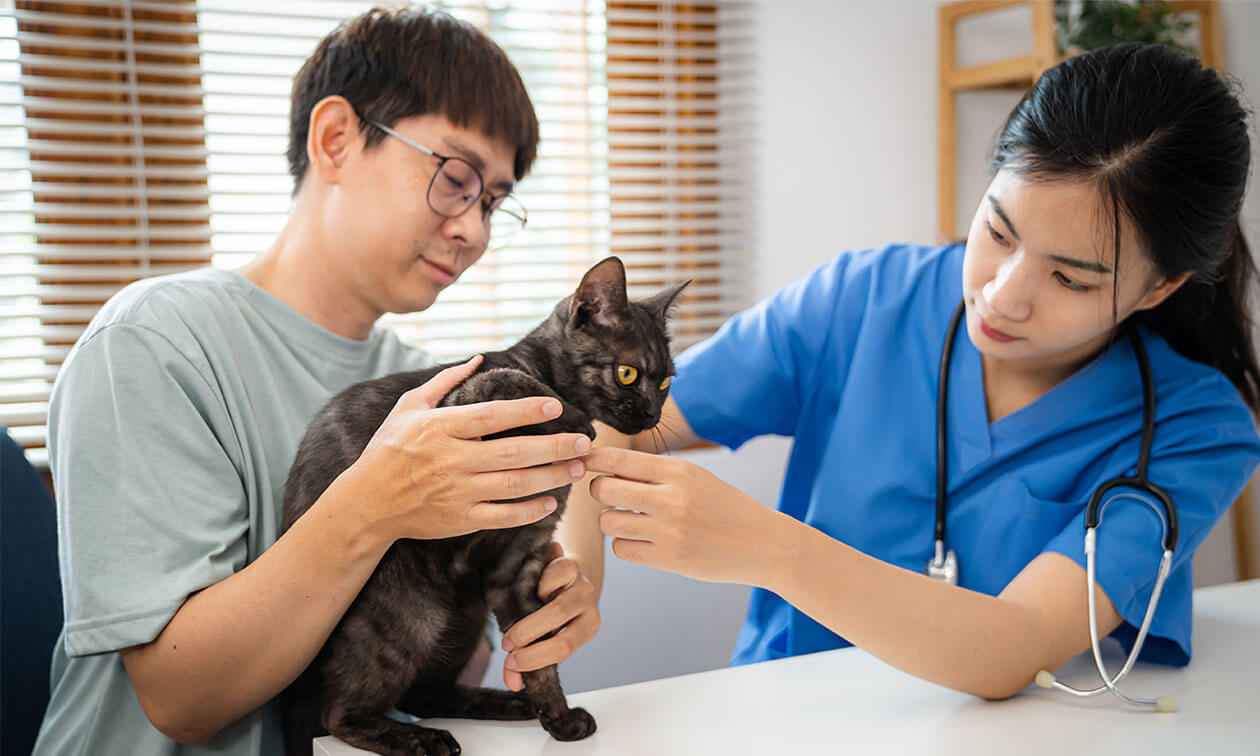Your role as a cat owner includes many responsibilities, like providing food, mental enrichment, and exercise. You know your cat also needs regular veterinary care, but have you considered your role as an advocate for your cat’s medical (and emotional) needs?
You play a big part in helping the veterinary care team provide the best possible care for your feline family member. That starts with being your cat’s advocate.
What Does It Mean to Advocate for Your Cat?
The simplest definition of advocating is speaking up for your cat. They can’t express their needs, tell their veterinarian about their aches and pains, question a procedure or recommendation, give input on their care plan, etc. That responsibility falls to you.
You know your cat better than anyone else. You’ll notice subtle clues about how they’re feeling. You know what causes fear and stress. You are their voice.
Tips to Advocate for Your Cat’s Physical Health
Here are some advocacy tips and things to consider when working with your veterinary team.
Know Your Cat’s Health History
You’ll likely work with many veterinarians throughout your cat’s life. The older your cat is, the longer their medical records will be. You can help your vet by having important medical information top of mind to share during each visit.
Start a running list that you can update with any new, relevant information after each appointment. Then you’ll have it easily accessible for the next appointment.
Watch for Changes in Your Cat’s “Normal" Behavior
Cats are very good at hiding pain and discomfort. The best way to catch potential medical issues early is to know your cat’s unique routines, preferences, and behaviors so you can quickly pick up on changes.
You can share information with your vet when you notice something out of the ordinary, like your cat isn’t running or jumping the way they used to, or they’ve started peeing standing up instead of squatting or going potty outside the litter box. Make a note or record the behavior on your phone, and log the time of day, frequency, and duration. Even small details (like the two examples above) can help lead to a diagnosis, such as muscle injury or osteoarthritis.
Don’t Be Afraid To Speak Up
Your veterinarian is an expert, but you are too. You know your cat. If your gut tells you something isn’t right, you should say so. Even if you have no idea where to point your vet, just sharing your feeling that there may be an issue is valid. Then your vet can ask questions, run tests, and work on finding a diagnosis or easing your concerns.
Be Part of the Care Plan
Ask questions. If you still don’t understand, ask again. Have your veterinarian explain not just what they’re doing but why. The more you know about the situation, diagnosis, and possible treatment, the better you can advocate and provide for your cat’s needs. If you know your cat prefers a specific way to take medication, let your veterinarian know so they can prescribe the best medication for your cat.
For example, if your cat is diagnosed with osteoarthritis, have a detailed conversation. Discuss the benefits of OA cat pain treatment, signs that the treatment is working well, what mobility changes you’d see if your cat were still experiencing discomfort, etc. This proactive approach ensures you’ll provide the best care for your cat and quickly recognize when their needs change.
Tips to Advocate for Your Cat’s Emotional Health
Being an advocate also includes looking out for your cat’s emotional needs. These are often closely tied to their medical needs. It is important to share if your cat has had one or more negative experiences when transporting them to the vet or during their vet visit as this could minimize subsequent triggers that may arise.
Share Your Cat’s Triggers
Let the veterinary care team know if specific procedures and handling cause your cat fear or stress. Ask them to make some accommodations to support your cat.
For example, speaking in a soft voice, removing the top of the carrier so your cat can stay in the bottom where they feel more secure, taking a break if your cat gets nervous, and other simple adjustments can do wonders to ease your cat’s fear. Having a calm cat can even improve the chances of a clear, thorough exam with an accurate diagnosis.
Talk About Feelings and Expectations
Talk to your vet about the emotional impact of your cat’s medical condition and whether support might be needed.
For example, a cat experiencing chronic pain may also have fear, anxiety, and stress. They may be fearful because they’re less able to defend themselves, or depressed because their activity level has dropped.
Your cat needs emotional support just as you would in a challenging time. That may be increased pain management, anxiety medication, calming supplements, working with a behavior consultant to reduce stress, or any number of other approaches. This is an important conversation to have with your vet. A healthy relationship with your veterinary care team is a wonderful way to support your cat’s physical and emotional needs. Share your concerns, speak openly and honestly, and be a strong voice for your feline family member. Advocating for you cat and trusting your veterinarian will provide the best care for your cat.
SLN-00700
IMPORTANT SAFETY INFORMATION: For use in cats only. Women who are pregnant, trying to conceive or breastfeeding should take extreme care to avoid self-injection. Allergic reactions, including anaphylaxis, could potentially occur with self-injection. SOLENSIA should not be used in breeding cats or in pregnant or lactating queens. SOLENSIA should not be administered to cats with a known allergy to frunevetmab. The most common adverse events reported in a clinical study were vomiting and injection site pain. Solensia may be associated with scabbing of the head and neck, dermatitis, and pruritus. See full Prescribing Information.
INDICATION: For the control of pain associated with osteoarthritis in cats.




